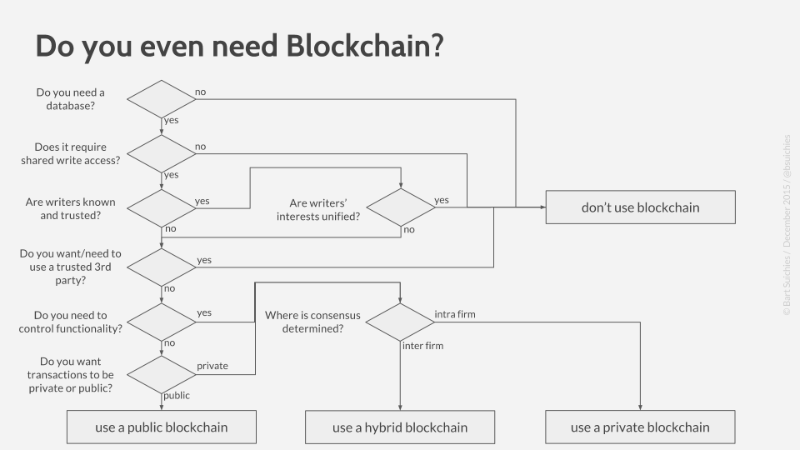Blockchain Technology Review
What is blockchain?
A blockchain is an incorruptible distributed ledger that is…
- Hosted by multiple parties
- Secured by crypto algorithms
- Append-only/immutable and thus verifiable in data storage
How does it work?

Categorization: Public vs. Private vs. Hybrid Blockchains
- Public: It is permission-less to join the network.
- Private: The permission to join is centrally controlled.
- Hybrid: Multi-parties control the permission to join.
Do you need a blockchain?

Architecture
-
Hardware: computer resources = computing + networking + storage
-
Basic Utils: P2P network + crypto + data storage w/ db or filesystem
-
Ledger: chain of data blocks + domain-specific data models
-
Consensus: write first consensus later (PoW/PoS/DPoS) / consensus first write later (PBFT)
-
Smart Contract: limited program running on the blockchain
-
API: RPC + SDK
-
dApps: 1) transfer of values 2) data certification 3) data access control
-
DevOps: deployment, operations, metrics, logs
Industries
-
Financial Services
- crypto exchange: binance, coinbase, etc.
- international payments: ripple, stellar, etc.
- Know Your Customer (KYC) / anti-money laundry (AML): civic
-
Health care
- sharing data across providers, insurers, vendors, auditors, etc
-
Public sector
- asset tokenization
- transparent voting in public election
-
Energy and resources
- trading
- sharing data across suppliers, shippers, contractors, and authorities
-
Technology, media, and telecom
- DRM and incentivizing content creator
- securing operations and data storage of IoT devices
-
Consumer and industrial products
- loyalty points programs in traveling
- document signing
- supply-chain management
Case Study: Ripple for Cross-border Payments
- Partnering with 200+ banks
- 47 trillion dollar cross-border payments market
- Huge hassles and costs. A large number of businesses cannot afford the high transaction fee of traditional cross-border payments.
- Without ripple, it may take days to fulfill the transaction in some African countries
- Quote the exchange rate
- Find the path in those hops
- Lock the quote
- Validate, KYC, AML, etc…
- With ripple, users in country A buys ripple tokens, pay with ripple, and then users in another country just withdraw. It just takes a few minutes and during which the token price will not fluctuate much.
- Without ripple, it may take days to fulfill the transaction in some African countries
Killer Apps
- Graphite Docs: Similar to Google Docs but everything is encrypted when data leaves your computer.
- Textile Photos: Phone App like a private Instagram. Photos are encrypted and stored on IPFS, a decentralized storage network running by the community.
- Augur: Web App where people can bet on predictions on many things.
- Blockstack: Tools for developers to build DApps.
- D.Tube: Video streaming service that is add-free but content creators are rewarded by tokens. Similarly ThetaNetwork for e-sports videos.
- OpenBazaar: Online marketplace with no platform fees, powered by cryptocurrency.
Challenges
- Network Effects. It is hard to convince users leaving existing well-established centralized services.
- Privacy vs. Free Services. Would people like to buy services with crypto? Or would people like to sacrifice privacy for free services?
- Efficiency in decentralized systems. Complex and decentralizes systems vs. simple and centralized systems.